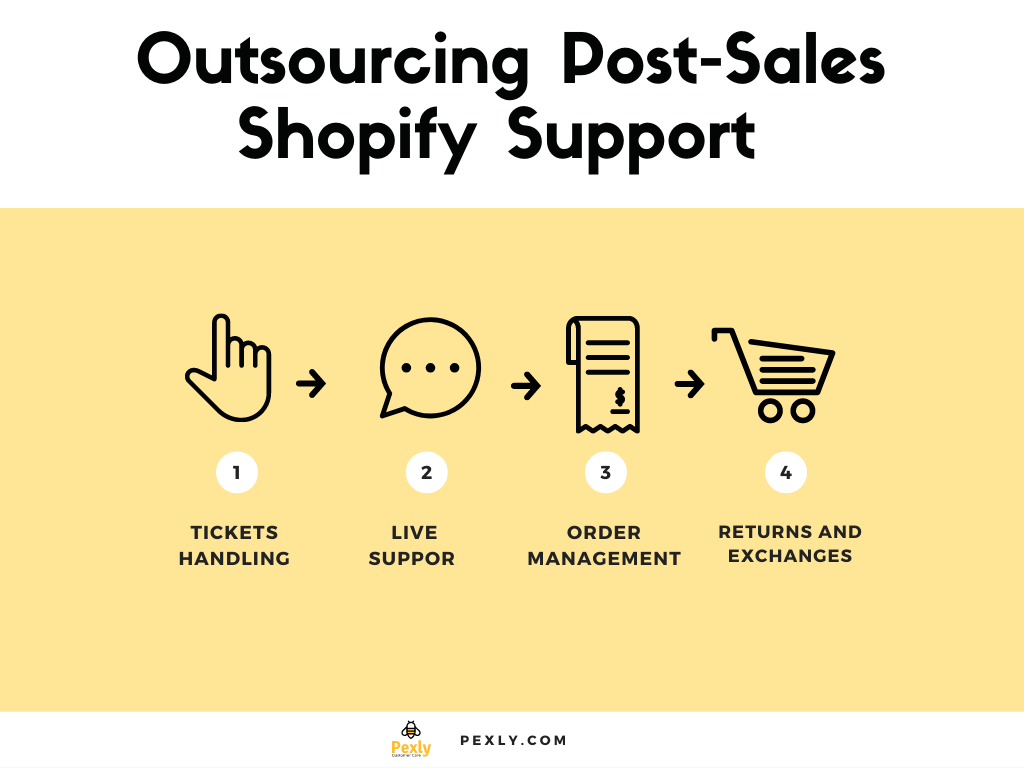Shopify is an e-commerce platform that offers services and tools by which you can create and develop a full-fledged online business. Both shoppers and entrepreneurs love it for its ease of use, versatility, and low price-to-big value for sellers. Shopify stores are available in 175 countries, and in 2020, the platform generated over 218 million purchases worldwide. However, in addition to simply having great products to sell, you also need to have the necessary levels of customer support to give your clients peace of mind.
Today we will talk about how you can outsource customer service to Shopify to provide unparalleled levels of service to your customers.
Outsourcing Post-Sales Shopify Support
It’s a tale as old as time. A lot of effort goes into wooing customers to your Shopify store, and then the moment customers are hooked, everything changes. Business interactions like this, where online stores try to trick you by, at first, providing stellar experiences to get you to buy. However, all of this goes away after the deal is made. After-sales service for your Shopify store is the remedy to this issue. Think of a customer as a long-term investment. You don’t just want them to make a one-time purchase but rather keep coming back to you over and over again.
There are many processes that fall into post-sales support category, and most, if not all, of them, can be outsourced. The following list contains some great things you can outsource:

Providing the types of services mentioned above will allow you to turn one-time buyers into loyal brand ambassadors. In a recent study conducted by Shep Hyken’s CX consulting firm, 96% of customers are willing to leave your business if they receive bad service. Consider offering services like Shopify 24/7 support to give your customers peace of mind knowing that you stand behind the products you sell and you will be there to answer their questions.
Outsourcing Pre-Sales Customer Support
The advantages of pre-sales support are often overlooked but crucial for Shopify stores since there is no salesperson involved. For business models like these, pre-sales support can significantly improve sales numbers, as well as customer experience and satisfaction. It could very well be a business opportunity worth pursuing. Before customers decide on making a purchase, they try to get as much information about your product(s) as possible. Pre-sales support will help customers get the answers they need to get them off the fence and decide on a favorable purchasing decision.
As far as your Shopify store is concerned, the pre-sales process involves answering customer inquiries across a wide variety of channels. One of the most popular services is Shopify customer support live chat since it offers customers the ability to get answers to their questions right away, and they don’t have to leave the mobile app or website to get these answers. This sort of support Shopify is very important for the overall revenue of your store and its reputation among current and potential customers.
Outsourcing Support Management and Strategy
Now that we learned about the various pre-sales and post-sales Shopify.com support services you can outsource, you still need to know how to implement all of these various processes. For example, let’s say that you would like to implement a Shopify support live chat. There are so many things you have to consider. First of all, do you need a dedicated agent, or will you manage with a shared one? Which languages and time zones do you need to support? How would you go about recruiting potential agents for your customer support team? While all of these processes have their complications and intricacies, the good news is that an experienced service provider will be able to help you manage all facets of customer service Shopify support.
Upon hearing your needs and what you are looking for, the service provider will set up an implementation strategy and help you manage the support offered to your customers. They will also be responsible for training the agents and helping them out with things like a Shopify knowledge base which will contain answers to some of the most common questions asked by customers. They will also implement princesses to make sure the highest levels of customer support are being followed. This includes periodic monitoring of support calls and offering agents feedback on how they can improve.
How to Outsource Your Shopify Customer Support
Outsourcing your Shopify customer support is an appealing idea. It can cut overheads significantly, saving you money, resources, and often, a great deal of stress. But it’s definitely not a one-size-fits-all solution, and there are no magic outsourcing beans you can use to make the process easier. That’s why you need to weigh your options carefully, especially when an external company could be directly interacting with your customers. Here are some of the steps you can take to start reaping the benefits of outsourced support:
- Establish a Baseline – The first step is to establish a baseline that you can share with your new provider, which will help them gain a clear understanding of what you’re currently doing with your Shopify site and customer service. So, for example, if you are currently offering Shopify customer chat, gather all of the records of transcripts of conversations that you have and give them to your service provider. They will determine the most frequently asked questions, then either write them down or forward the key emails/transcripts to your new provider so that they’re in the loop about your FAQs.
- Test Out the Baseline – After your preparation is complete, it’s time to implement your new provider’s technologies, process improvements that have been identified, systems configurations, and agent training. Before training your agents on Shopify live chat support or any other channel, you’ll want to determine your KPIs before training your agents. What does success look like to you? Less than forty-second response times on live chat? One-day email response times? Make sure you’re clear on what these key performance indicators are, and work with your provider to figure out how they can help you accomplish them.
- It’s Go Time – When it’s time, your provider will send you a snippet of the plan. They may have even built a self-service knowledge base for you. If they have, you should add that as the main navigation item on your website: “Help Center” or “Support.” You’ve flipped the switch and gone live, but that doesn’t mean you should stop testing the quality assurance of your Shopify customer service live chat and other channels.
- Have a Post Implementation Plan – Of course, you want to keep things running smoothly after transitioning to your new customer service provider. Handing them the keys and walking away isn’t the best strategy. There needs to be a plan on how to handle the Shopify online chat support and other channels. Work with the service provider to come up with such a plan.
Trust Pexly To Support Your Shopify Business
If you are looking for assistance in providing your customers with Shopify customer support chat and other support channels, consider hiring Pexly to provide your customers with all of the assistance they need. We have extensive experience actualizing customer support projects of all sizes and complexities and can come up with a solution that fits your individual needs. Contact us today to learn more about how we can help you.





